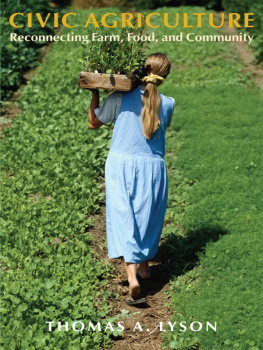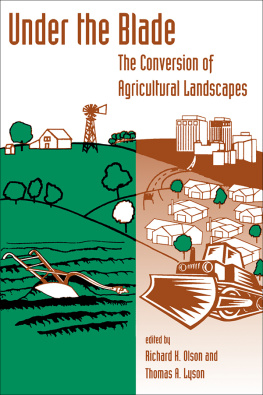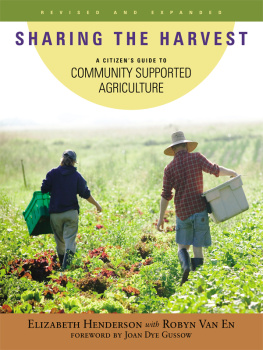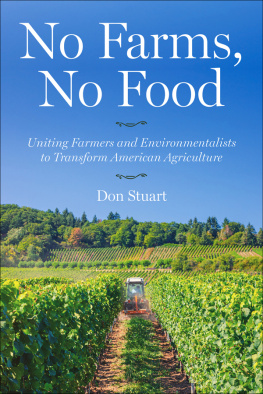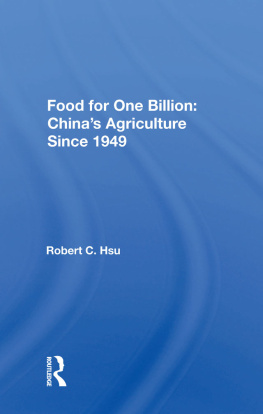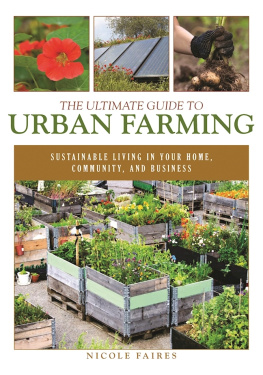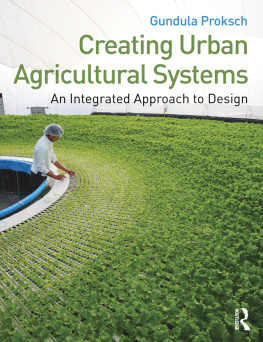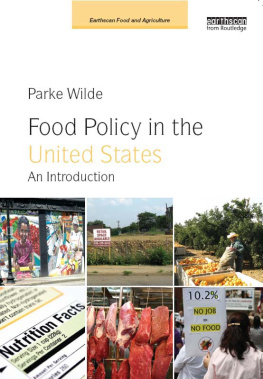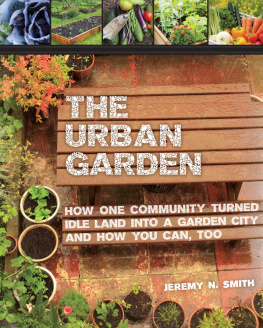Civic Agriculture
RECONNECTING FARM, FOOD, AND COMMUNITY

Thomas A. Lyson
TUFTS UNIVERSITY PRESS
Medford, Massachusetts
Published by University Press of New England
Hanover and London
TUFTS UNIVERSITY PRESS
Published by University Press of New England,
One Court Street, Lebanon, NH 03766
www.upne.com
2004 by Tufts University
All rights reserved. No part of this book may be reproduced in any form or by any electronic or mechanical means, including storage and retrieval systems, without permission in writing from the publisher, except by a reviewer, who may quote brief passages in a review. Members of educational institutions and organizations wishing to photocopy any of the work for classroom use, or authors and publishers who would like to obtain permission for any of the material in the work, should contact Permissions, University Press of New England, One Court Street, Lebanon, NH 03766.
ISBN s for the paperback edition:
ISBN -13: 978-1-58465-414-8
ISBN s for the eBook edition:
ISBN : 978-1-61168-303-5
Library of Congress Cataloging-in-Publication Data
Lyson, Thomas A.
Civic agriculture : reconnecting farm, food, and community / Thomas A. Lyson.
p. cm. (Civil society)
Includes bibliographical references and index.
ISBN 1584654139 (cloth : alk. paper) ISBN 1584654147 (pbk. : alk. paper)
1. AgricultureEconomic aspectsUnited States.
2. AgricultureSocial aspectsUnited States. 3. Agriculture,
CooperativeUnited States. 4. Community development
United States. I. Title. II. Series.
HD1761.l97 2004
CIVIL SOCIETY:
HISTORICAL AND CONTEMPORARY
PERSPECTIVEs
Series Editors
VIRGINIA HODGKINSON
Public Policy Institute
Georgetown University
KENT E. PORTNEY
Department of Political Science
Tufts University
JOHN C. SCHNEIDER
Department of History
Tufts University
Brian O'Connell, Civil Society: The Underpinnings of American Democracy
Philip H. Round, By Nature and by Custom Cursed: Transatlantic Civil Discourse and New England Cultural Production, 16201660
Bob Edwards, Michael W. Foley, and Mario Diani, eds. Beyond Tocqueville: Civil Society and the Social Capital Debate in Comparative Perspective
Ken Thomson, From Neighborhood to Nation: The Democratic Foundations of Civil Society
Henry Milner, Civic Literacy: How Informed Citizens Make Democracy Work
Virginia A. Hodgkinson and Michael W. Foley, eds., The Civil Society Reader
Thomas A. Lyson, Civic Agriculture: Reconnecting Farm, Food, and Community
FOR MY WIFE,
Loretta Carrillo
AND MY DAUGHTERS,
Mercedes Carrillo Lyson and Helena Carrillo Lyson

TABLES
Changes in the Structure of Agriculture from 1910 to 1997: Farms, Acres, Tractors, and Fertilizer
Farm Structure Information and Enterprise Diversification on U.S. Farms: 1910, 1950, 1997
Concentration of Agricultural Production by Various Commodities: 1997 Census of Agriculture
Top Ten States Ranked by Agricultural Sales: 1910, 1950, 1997
Top Ten Counties Ranked by Agricultural Sales: 1959 and 1997
Ten Largest Food-Processing Corporations: 2001
Ten Largest Grocery Store Chains in the United States: 2001
Share of Economic Activity within the Agricultural Sector Accounted for by Farmers, Input Suppliers, and Marketers: 1910 and 1990
Two Models of Agricultural Development
Selected Elements of Conventional Agriculture and Sustainable Agriculture
Six Characteristics of Civic Agriculture
Consumer Perspectives on Community-Supported Agriculture
Civic Agriculture Trends in New York State
ACKNOWLEDGMENTS
The path to civic agriculture began in 1988 when I became the director of Cornell's Farming Alternatives Program (FAP). Although the program was established during the farm crisis of the mid-1980s to help New York farmers ease out of dairying and into alternative enterprises, its mission changed in the 1990s from assisting individual farmers to working with groups of farmers and community development practitioners to promote a more sustainable agriculture and food system in the state. Sustainability became the focus of much of my research and writing during the 1990s. And it was during this period that the emergence of a new form of agriculture and food production became visible. Farmers markets were springing up everywhere around New York State. Small-scale food processors appeared on the radar screen. Community and school gardens began dotting the landscape. And organic farmers were organizing into networks to more effectively market their products.
For a while we called these emerging forms of agriculture and food production the New Agriculture. They were new in many important and significant ways, not the least of which was that they had strong ties to community and the environment. But there was another New Agriculture on the block. The nation's agricultural biotechnology companies were proclaiming that genetically modified organisms (GMOs) were going to serve as the foundation of a New Agriculture that would feed the world. If the biotechnology corporations had appropriated the term New Agriculture for their purposes, what did we have?
The new forms of production, processing, and distribution that we were tracking clearly had a connection to place and people. They were more than just a set of new production techniques. They were civic. And so in 1999 I coined the term civic agriculture in a paper I delivered at the annual meetings of the Rural Sociological Society.
I owe thanks to many individuals for their support, assistance, and encouragement. My colleagues in the Community, Food, and Agriculture Program (formerly the Farming Alternatives Program), Joanna Green, Heidi Mouillessaux-Kunzman, Duncan Hilchey, and Gretchen Gilbert, have integrated many of the civic concepts into their work and put a human face on civic agriculture.
Over the past fifteen years Gil Gillespie and I have worked on several large agriculture and food system projects. The results generated from these projects have provided grist for this book. Jennifer Wilkins in the Division of Nutritional Sciences at Cornell showed me the connection of my work to community nutrition. Phil McMichael's work on global food systems served as a very useful counterpoint to my interest in the local. Jeff Sobal's conceptual work on the agriculture and food system helped me situate my work in a broader systems context.
I have had the good fortune to work with many talented graduate students at Cornell. I have learned from all of them. Melanie DuPuis showed me how state-level agricultural policy preserved family farming in some places while leading to industrialization in other areas. Clare Hinrichs looked at how farming, family, and community are bound together. Rick Welsh delved into the survival strategies of family farmers. Beth Barham compared the sustainable agriculture movement in France with that in the United States. Bob Torres showed how denominations of origin can nurture local agriculture development. Robin Kreider has shown how informal organic marketing standards become formalized. And Matt Hoffman has tested the civic agriculture model in Vermont.
Outside of Cornell, Doug Harper's work on changing works among dairy farmers in the Northeast showed me how community and farming could be brought together. My understanding of the civic community benefited from my collaborations with Charlie Tolbert, Mike Irwin, and Troy Blanchard. Gail Feenstra and Mike Hamm read my manuscript with a critical eye. Their comments and suggestions are much appreciated.

